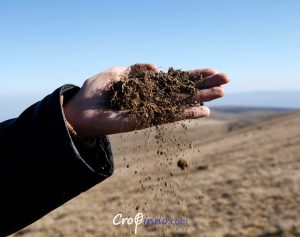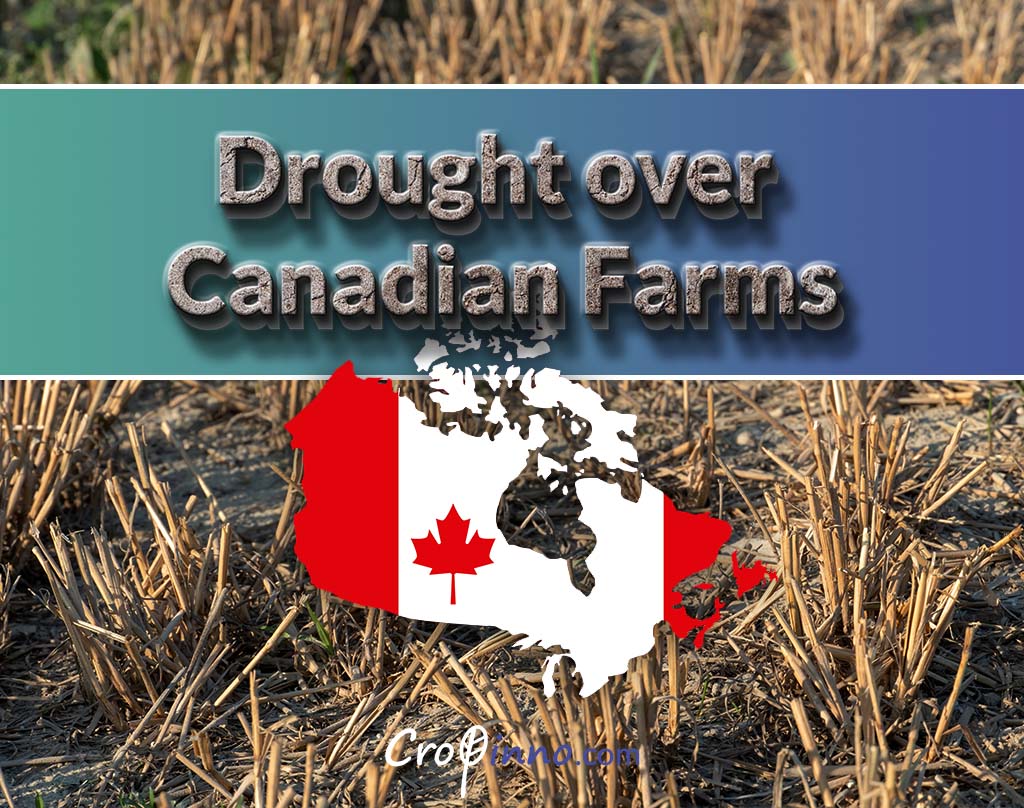Nothing grows without water, and that is just the fact of life.
It is 2022; The world is depending on Canada, the world’s breadbasket, to increase the wheat and canola crops this year in order to reduce food inflation brought on by the Russia-Ukraine war. However, Canadian farmers may experience another drought this year.
Over Saskatchewan and Manitoba, the growing season has had a tough start due to the extreme drought that has affected these areas. Unusual dry conditions over the Prairies will endanger crops, impair the water supply, and raise the possibility of fires. The harvest in Canada last year was reduced by dry circumstances, while wheat harvests in China and the United States are also affected. According to the estimates from U.S. Department of Agriculture, Prior to the drought in 2020, about 13% of the world’s traded wheat came from Canada.
Russia’s invasion of Ukraine boosted Minneapolis spring wheat prices to 14-year highs, as the two countries accounted for about 30% of world supply. Ukraine is also a major producer of vegetable oil, and canola prices have reached all-time highs. Spring-seeded crops in Canada are now being considered to help make up the shortage. Southern Manitoba has received a lot of snow this year. However, much of the Canadian Prairies remain dry, with southern Alberta and central Saskatchewan being under “severe drought” as of Feb. 28, according to Canada’s drought monitor. There is no adequate reserve of moisture in the soil that would normally remain after the winter because most of it was depleted last year.
Agroclimatic specialists believe that Canadian farms are extremely vulnerable to dry periods this year.
Drought: a definition
The absence of moisture from snow and rain causes droughts. Low snowpacks, low precipitation, low soil moisture, and high temperatures have all contributed to the current drought in Canadian farms, which began on the Prairies last summer. The absence of dugouts, which store water for irrigation, indicated that the farmland had very little moisture at the beginning of the season. These circumstances are affecting a lot of grain growers across the nation this year.
Beginning with low moisture in the spring, producers relied on timely rains early in the season. Some farmers were fortunate enough to receive small amounts of rain at the right time, while others were not, resulting in delayed or uneven germination and underdeveloped crop. The extreme heat in western Canada in June and July hit crops at their most vulnerable time, further reducing yields. Overall, 80 to 90 percent of the drought-affected area across the prairies will have smaller grain crops of lower quality this year.

Is climate change the reason?
Droughts are a common part of the climate cycle in western Canada and the western United States, making it difficult to relate them only to climate change. However, according to the UN’s most recent Intergovernmental panel on Climate Change report, droughts will become more frequent and severe in the future. The 2021 drought in Canadian farms was one of the driest one-year droughts on record. This drought also affected the largest area of Canada in the last 50 or 60 years.
The effects of drought
Cattle, sheep, and goat producers have struggled to find water and feed for their animals. Due to a lack of winter snowmelt, some water sources were not recharged, and pasture growth to feed animals did not regenerate due to hot and dry conditions. Livestock farmers have had to buy more feed or move their animals in order to find grass, which is difficult when most of the prairies have none. Because they couldn’t find water or feed, many farmers began selling their cattle.
This means that Canada may have to import more cattle from the United States, putting related infrastructure, such as feedlots and packing plants, at risk. These losses may cause some farmers to abandon farming entirely, resulting in further loss of grassland and biodiversity. Grain farmers will earn less money than they did last year. The profit margins for the Canadian f armers are very tight. They must spend a lot of money to plant a crop in the hopes of recouping their investment and supporting their families. While grain prices have been rising, if a farmer’s harvest is cut in half from the previous year, that means loss to them.
Additionally, a lot of weeds, insects, illnesses, and mold can appear during a drought. Grasshoppers flourish in hot, dry conditions, and in certain prairies regions, they have been destroying farmers’ meagre crops.

Production of principal field crops in Canada
In 2021 compared to 2020, Canadian farmers produced more maize for grain but less wheat, canola, barley, soybeans, and oats. Drought conditions in Western Canada contributed significantly to reduced crops and lower production.
Despite ideal spring sowing conditions for the majority of Canada, Western Canada’s crop development was hampered by exceptionally hot and dry weather. The majority of the growing season in Eastern Canada had temperatures that were close to normal, with ample moisture in Southern Ontario and the Atlantic provinces but dry weather in much of Quebec.
Due to decreasing productivity in the Prairies, total wheat production decreased 38.5 percent to 21.7 million tonnes in 2021. In comparison to 2020, yields decreased by 33.3 percent to 34.8 bushels per acre and harvested area decreased by 7.7 percent to 22.8 million acres.
Saskatchewan had a 48.1 percent decline in wheat production to 8.3 million tonnes as yields fell by 43.4 percent to 26.0 bushels per acre and harvested area fell by 8.3 percent to 11.7 million acres.
In Alberta, production fell by 42.9 percent to 6.3 million tonnes as a result of declining yields (-38.4 percent to 34.4 bushels per acre) and harvested area (-7.5 percent to 6.7 million acres).
The amount of wheat produced in Manitoba decreased by 28.9% to 3.8 million tonnes. While harvested area fell 8.9 percent, yields fell by 21.9% to 47.9 bushels per acre.
The drought in Western Canada led to the lowest output since 2007 and a 35.4 percent national decline in canola production to 12.6 million tonnes in 2021. yield declines of 40.2% to 25.0 bushels per acre overcame higher harvested area (+8.2 percent to 22.3 million acres).
Due to reduced yields (-48.5 percent to 22.0 bushels per acre) countering higher harvested area (+6.2 percent to 12.0 million acres), canola output in Saskatchewan decreased by 45.4 percent to 6.0 million tonnes.
In Alberta, with harvested area up 16.3 percent and canola yield down 31.1 percent to 27.7 bushels per acre, production fell 19.9 percent to 4.2 million tonnes in comparison to 2020.
The amount of canola produced in Manitoba decreased by 28.2% to 2.3 million tonnes. While yields decreased 28.3 percent to 29.7 bushels per acre, harvested area increased by 0.3 percent to 3.4 million acres.
In 2021, Canada’s overall production of corn for grain increased by 3.1% to 14.0 million tonnes. While yields increased 4.4 percent to 160.2 bushels per acre, harvested area decreased 1.3 percent to 3.4 million acres.
soybean production nationally fell by 1.4 percent in 2021 to 6.3 million tonnes. A 4.5 percent increase in harvested area was offset by a 5.6 percent fall in yields. Due to dry conditions throughout the growing season, decreased yields in Manitoba were a major contributor to lower national production.
In 2021, the production of barley decreased 35.3% to 6.9 million tonnes. Due to the dry weather in Western Canada, yields decreased (-39.5 percent to 43.0 bushels per acre) even though harvested area increased (+6.9 percent to 7.4 million acres).
Total oat production decreased by 43.0% nationally to 2.6 million tonnes, with lower harvested areas (-15.4% to 2.7 million acres) and lower yields (-32.6% to 61.5 bushels per acre).
Prices to keep going up
Sylvain Charlebois, a professor and senior director of the Food Analytics Lab at Dalhousie University in Halifax, claims that droughts are not just occurring in Canada but also in some areas of the United States and Russia, which has an impact on the harvest potential throughout the entire northern hemisphere. Prices are greater than usual, and that will certainly affect input costs further down the food chain, specifically in processing.
Farmers’ mental health
The Anxiety, depression and stress are now spreading among Canadian farmers who are facing drought in Canadian farms. The difficulty of facing a drought along with the heavy burden of normal agricultural activities, has real physical and mental impacts on farmers. Because of the drought and its many consequences, the farming community is exposed to both chronic (sustained) and acute (sudden) stress.
Will drought continue?
It is very difficult to make an accurate forecast about the drought situation, but what we have observed through the analysis of satellite images of consecutive years over Canadian lands shows the high severity of the drought this year and its overall increasing progress over the past few years. The difficulty in predicting weather phenomena due to climate change does not allow us to know when the necessary moisture will return to Canadian fields. We can hope to some extent for the usual fall and winter precipitation, but even so, some fields will need years to recover back to normal.

